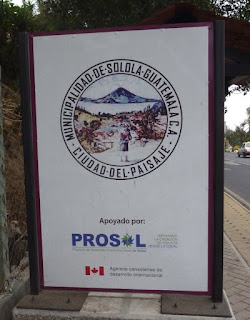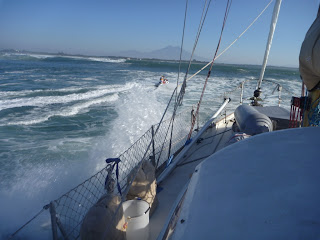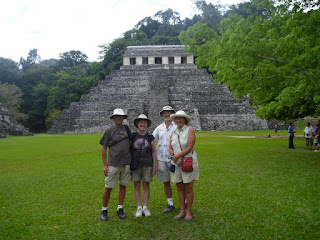Another blistering hot day in El Salvador. It is 10PM and it is still 80F in the cabin. Thankfully the breeze we have during the day makes it feel a bit cooler but it has died and now the breeze is a manufactured one – 12 V fans.
Fran and I have had another busy day. We went to San Salvador using the local bus system. What an experience! We left mid-morning to make a 2PM dental appointment in town for Fran. We caught the local bus at the resort gate and rode it for an hour to the highway junction to the city where we transferred to another similar bus for another 45 minute run. These buses are mostly of the old Bluebird school bus variety, most likely recycled from the US. They are all modified to carry more passengers and most are worse for wear, however, they run on time and they are an efficient mode of transport. One weird (to us) custom is for the driver to allow hucksters aboard at various stops or at the station before departure. These people sell anything from gum to candy bars, fruit, religious calendars, cookbooks, pastries, chips (banana, potato or coconut with your choice of sauerkraut, salt and hot sauce), plastic bags of water (actually factory filled and sealed 1 litre bags – bite off a corner and drink) and a host of other items. We bought a dollar bag of strawberries and peanuts (complete with a small bag of hot sauce and lime juice). When in Rome..... we were disturbed to see that any and all trash is thrown out of the windows adding to the litter along the roads.
Other than the trip there and back the event wasn’t noteworthy except that there was nothing wrong with Fran’s teeth. She thought she had cracked one. We also discovered Central America’s version of Costco – Pricesmart. It will be a very good source when we re-provision in the fall. Lunch was at Pollo Campero, a Central American chain that brought inexpensive fast food (chicken in this case) to the masses. The chain is expanding into the US and Japan.
Our trip to Guatemala was very pleasant. It was an expensive outing but, this time, we let someone else do the driving. We managed to have Rosie bunk in with Chris and Alan on Beverly-J for the time we were away so that freed us up for a more relaxing time. Once again we teamed up with Ken and Carole (Nauti Moments) and took a 3-day tour with driver and tour guide. We spent a lot of time driving from place to place but the van was air-conditioned and very comfortable. Our tour guide, Benjamin, spoke good English and had much to tell us about El Salvador and Guatemala. It is hard to believe that both countries were rife with political unrest within the past 20 years. Benjamin had some first-hand accounts of some of the horrifying events that unfolded in the early 1990’s and how the US (CIA) came to the aid of both countries to stall any further incursion by the Soviet hordes...... We noticed a big difference from Mexico with the amount of US influence in both countries. Every fast food chain is represented and US aid money is obvious everywhere. We did saw a sign in Atitlan expounding the aid provided by Canada for small businesses.
Sign in Atitlan about Canadian Aid to Small Business
Crossing into Guatemala was a much easier process than what we have experienced with our check-in and out of Mexico. It took only a cursory check of our passports and a stamp and we were on our way. Our first stop was Antigua, a beautiful colonial town, founded in 1543 and a UNESCO World Heritage Site since 1979. The town is nestled between a trio of volcanoes of which Fuego is still active and emits a steady stream of vapour. The city has 38 churches but only a few were rebuilt after a devastating earthquake in 1773 that destroyed most of the city. We met many Europeans and had a fun time wandering the streets around the square and selecting a restaurant for dinner. One, featuring lamb, venison stew and another meat stew we couldn’t identify, drew us in. J-G, being the “gotta try it once” guy, went for the latter which actually turned out to be the most succulent of the 3 choices. It turns out that the meat is of the sheep family but one sporting hair rather than wool. After a night at a very nice hotel (Hotel Carmen) we spent a few hours touring the town before heading off to Lake Atitlan. We visited a jade factory, a native market but were turned away from a very scenic hotel by a bunch of serious looking guys in suits, sunglasses and ear-pieces. It just so happened that Antigua was hosting the presidents of the Central American countries for a meeting on Drug control. As we drove out of town we saw hundreds of police and military that weren’t there the previous afternoon.
Fuego Volcano from Antigua
Antigua cathedral with hand-laid coloured salt crystal carpet and fruit/veg offerings for Easter. Alter is covered by a 3-D scene which is changed daily.

School girls and religious procession, town square, Antigua
Our next destination was Lake Atitlan, a 128 sq km lake in a sunken volcanic crater, 1000 ft deep, surrounded by 3 other volcanic peaks. We spent the afternoon taking a boat across the lake to visit 3 isolated villages, San Juan, San Pedro and Santiago where people make traditional native crafts, now exclusively for the visiting tourists. At the last stop we were getting late in the afternoon and the peddlers were getting anxious to make their last sales. One lady followed Fran for 3 blocks trying to sell her a skirt. She finally wore Fran down but settled for a fraction of her initial asking price, which was probably what she expected to get anyway.
Look who's afraid of a bit of spray - fresh water spray.
Incredible sunset scene over lake Atitlan with storm clouds brewing overhead.
The following morning we went to Chichicastenango, an indigenous market town where everything we had seen in the previous 2 days and much more was for sale. The roads in the mountains were bordered with lush fields and terraced gardens where a wide variety of market crops were being grown. This was a marked difference from what we had observed in Mexico on our trip to Palenque where the natives eked a living growing corn and coffee everywhere there was a patch of soil, no matter how steep the hillside. We all wondered whether this was another instance of US aid at work.
Shopping in Chichicastenango
Ken and Carole - Chichicastenango market
Well, we are back on the bay and are slowly gearing up to leave at the end of April. We have now committed ourselves to an Apr 26 departure. We have had some issues getting a flight where we can take Rosie. Finally yesterday, after several frustrating attempts to get answers from United Airlines, we got the green light but it will not be easy. She needs a vet’s checkup within 5 days of departure (at a vet in San Salvador), must be weighed at the airport the previous day and must arrive 3 hours before our 0630 departure time and all this will have to be done by taxi. When we arrive in Houston (on our way to Phoenix because they don’t have pressurise cargo holds on the planes that fly directly to Tucson) we need a minimum of 3 hour layover so that she can be checked out by US officials. What a hassle!!
2030, Friday, 30 March, Still anchored
Over the last few days we have had some leisurely lazy days. Mornings are projects times, before it gets too hot. We have been setting up a sun shade using fence coverings used at the Winter Olympics in Vancouver. The panels are 6’ by 40’ and we have 2 of them, obtained from a provincial surplus outlet in Victoria. All we have to do is adapt them to the boat by cutting out sections where the rigging interferes with the layout. Easier said than done working on a sailboat. In the meantime we have set up an old shade we found on the boat when we bought her. So far that is working well so the other project has taken a back seat. Apart from walking Rosie, cooling off in a pool that is just below ambient temperature and waiting for Happy Hour at poolside, chatting with other cruisers there isn’t much exciting happening. Every few nights there is something special happening. Tonight there was a wine tasting followed by an Italian dinner at the resort but Fran is under the weather so we opted for a nice quiet spaghetti supper onboard.
Today J-G went on a short excursion to a nearby town with a bunch of cruisers to participate in a school fruit festival. The kids and parents welcomed us graciously and we enjoyed a few hours of entertainment and fruit tasting. J-G added 3 more exotic species to his list.
Next week is Semana Santa here and it is promising to be an absolute ZOO. The week before Easter is Latin America’s Spring Break. The management has all their units rented out as do most of the resorts and hotels along the strip. The waterway we are anchored in will be very busy so Rosie will get her exercise chasing watercraft from one end of gosling to the other. Beer tents have popped up all down the road and 2 circuses have set up camp a few miles away. This would be a good time to be away but it will be crazy everywhere so we will just have to hunker down and survive the onslaught....



























